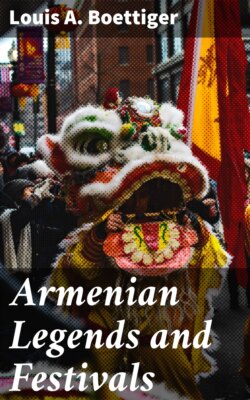Читать книгу Armenian Legends and Festivals - Louis A. Boettiger - Страница 8
Section 1. The Legend of Haic
ОглавлениеArmenians do not call themselves Armenians nor their country Armenia. They are descendants of Haic, as the legend goes, who was the son of Togarmah, the son of Japhet, who was the son of Noah, and they call their country Haiasdan after the patriarchal progenitor of their people.1 Haic dwelt in the plain of Shinar and was a prefect or director in the building of the tower of Babel. He was beautiful as a god and strong as a giant, mighty in battle and especially adept in spear throwing. In the days of his youth, Bel or Nimrod, who was the patron god of Babylon, established himself over all and wished to be worshipped. But Haic refused to obey, and taking his sons, who numbered about three hundred, his daughters, his sheep and cattle, he journeyed north until he came to the land of Ararat. Bel tried in vain to persuade his rival to come back.
“Thou hast departed and hast settled in a chill and frosty region,” urged the Assyrian god. “Soften thy hard pride, change thy coldness to geniality; be my subject and come and live a life of ease in my domain.”2
But Haic refused the cordial invitation, which so much angered Bel that the latter brought his army to force the Armenian hero into submission. Haic, however, was victorious, for he slew Bel with an arrow from his own bow. The place where Bel was buried is called “Kerezman,” meaning grave, and is pointed out to this day. Armenians sing songs and tell stories of the great beauty and valor of Haic. He died at the age of four hundred in about 2028 B.C.3
This oldest of Armenian legends, quaint and simple as it is in accounting for the beginnings of a people, savours of the Old Testament and is suggestive of the Assyrian invasion which took place about the ninth century before Christ. It is significant that the Armenians refused the protection of Bel, and that in the very beginning of their legendary history, they insisted on standing firm and maintaining their independence, for no single quality is more characteristic of this people than a proud, haughty, even at times disdainful independence. It is also suggestive that their patriarchal hero was no saint, but a mighty giant, beautiful as he was strong, whose greatest pride was in the throwing of a spear, for his descendants have not been a peaceful people. To be sure, they were the first nation to be converted to Christianity, which would say little for their firmness and independence, were it not that the priest with the cross was followed by a powerful king with a sword at the head of an army that had learned to fight as the Romans fought.4 The songs that were sung in memory and honor of Haic are seldom sung to-day unless it be in some remote village where the civilization of the Turk has not yet pressed, and there are few such villages if any. For many of them breathe of a national spirit not beseeming a subject nation, and have been suppressed for many years.
